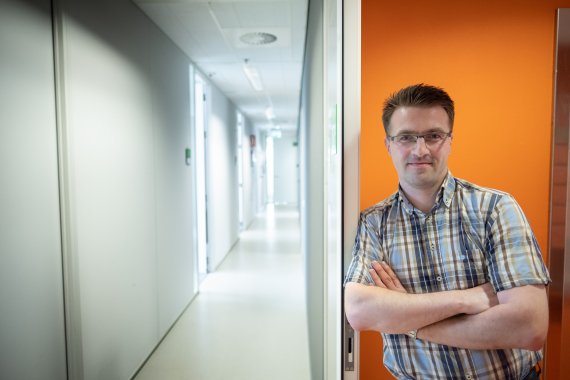Fred Jonker: ‘We have taken the wishes of the chair groups into account as fully as possible in the timetabling.’ Photo Guy Ackermans
Happy with the new timetable?
‘I feel it is very well-balanced. With a longer teaching day we can make better use of buildings. At the same time, we can keep the inconvenience to a minimum and spread it fairly. We are really taking a step forward, keeping in mind the wishes of the faculty and of the Student-Staff Council.’
How many courses do you have to timetable, actually?
‘There are an average of 200 courses per period. There are more big courses in the first and second periods, and a lot of small courses in period 5. In periods 3 and 4, which are shorter, there are about over 100 courses. We only timetable the courses and rooms, not the teachers. That is done in the chair groups.’
Students and teachers objected to the loss of long lunch breaks for consultation time. How have you catered for that?
‘We agreed with the Student-Staff Council that we would divide the courses of each degree programme into two groups. That way we can guarantee per week that students would be free in the sixth period of the day, just before the lunch break, either on Tuesday and Friday or on Wednesday and Thursday.’
What new possibilities does the timetable offer?
‘It offers more flexibility for courses because there are now six periods in the morning and six in the afternoon. We are now seeing that for regular courses people are more often requesting 2×3 class periods per week instead of 3×2 periods. Two periods on the old timetable was sometimes just too short, while three hours was too long. Only for the practicals we don’t gain much. Practicals often need 4 to 5 periods, so you don’t make optimal use of the morning or afternoon. We would therefore like to challenge teachers to start working with two groups, where possible, who do practicals one after the other in blocks of three periods. Then they could hold practicals for half days over three weeks instead of full days for two weeks. That saves space and enables the team of teachers to provide for more students. This adaptation takes time, though, and we are willing to take the time for it. Such alternating groups will be starting this coming year for lectures, classes and group work.’
Do you expect a lot of requests for changes after publication?
‘I do expect a bit more repair work than in an average year, but I am confident the timetable will deliver what we expect it to. Chair groups have filled in rather more wishes than usual this year, and we have taken those into account as fully as possible. Where there were no special requests, we timetable the course just like last year, as far as possible. We look at Wi-Fi use too: you can see from that whether a room has really been used. Did a lecture always start half an hour late, or did it always finish early? You’d be surprised to hear how much Wi-Fi traffic there is during exams, by the way. Teachers who imagine all the mobile phones are switched off in their classrooms would be in for a shock.’
| Remind me what it’s all about? | Why the new timetable? | WUR is bursting at the seams. The extended timetable is supposed to cater for the growing numbers while avoiding classes after 19:00 hours and any need to immediately invest in a big new teaching building. |
|---|---|---|
| What is changing? | The teaching day will be longer, from 8:20 to 19:00. There will be 12 class slots of 40 minutes (instead of 10 of 45 minutes), with alternating breaks of 10 and 20 minutes between them. The half-hour lunch break will shift to 13:30. Students on a regular programme will have classes until 19:00 a maximum of twice a week. | |
| No more classes at De Dreijen? | Because there are still renovations and moving going on in Atlas, for the time being two labs for practicals, three PC rooms and one lecture hall are in use at De Dreijen. |
| Remind me what it’s all about? | Why the new timetable? |
|---|---|
| WUR is bursting at the seams. The extended timetable is supposed to cater for the growing numbers while avoiding classes after 19:00 hours and any need to immediately invest in a big new teaching building. | |
| What is changing? | |
| The teaching day will be longer, from 8:20 to 19:00. There will be 12 class slots of 40 minutes (instead of 10 of 45 minutes), with alternating breaks of 10 and 20 minutes between them. The half-hour lunch break will shift to 13:30. Students on a regular programme will have classes until 19:00 a maximum of twice a week. | |
| No more classes at De Dreijen? | |
| Because there are still renovations and moving going on in Atlas, for the time being two labs for practicals, three PC rooms and one lecture hall are in use at De Dreijen. |

